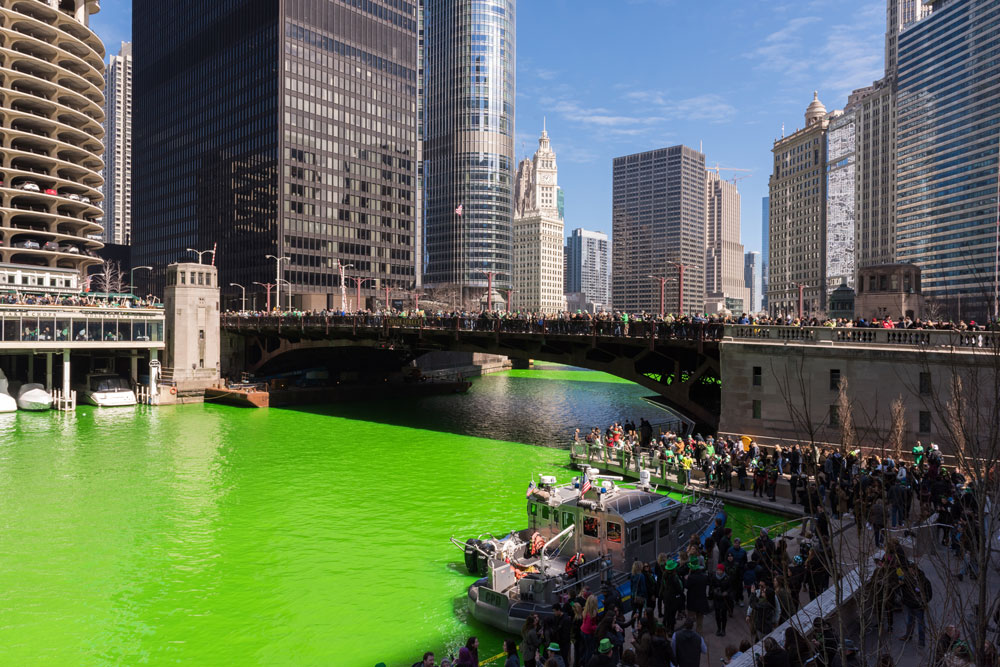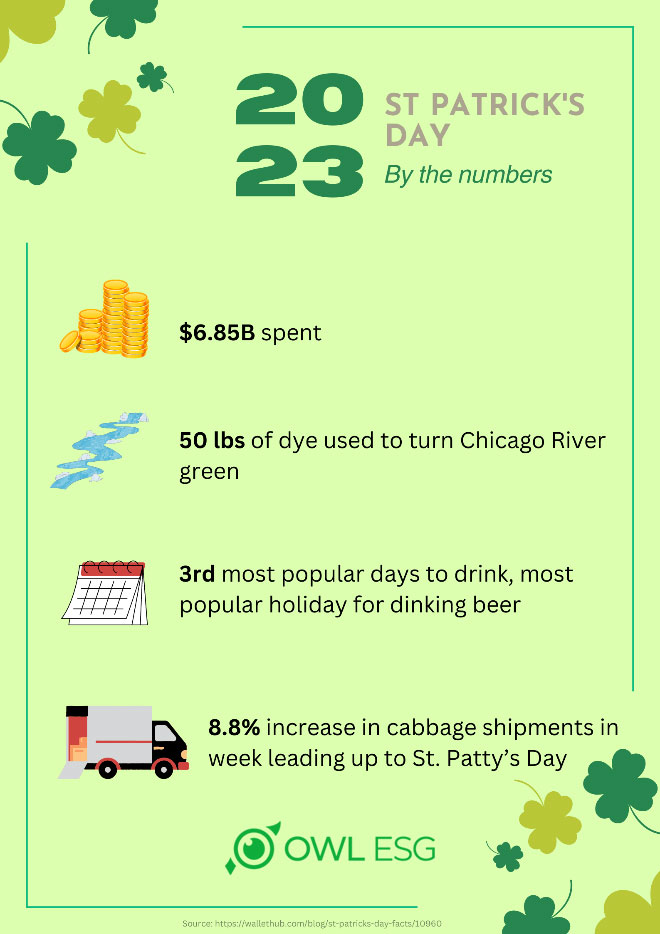Green Celebrations: Navigating the Environmental Impact of St. Patrick’s Day
As St. Patrick’s Day approaches, cities around the world prepare for a sea of green, lively parades, and joyous celebrations in honor of the patron saint of Ireland. While the day is synonymous with leprechauns, beer, and all things green, festivities aren’t necessarily lucky for the environment. After all, dyeing the Chicago River green isn’t the “greenest” of ideas. Amidst the green decorations, there lies a paradox that demands our attention.

The Green Dilemma
St. Patrick’s Day is often associated with green, a symbol of luck and the lush landscapes of Ireland. Yet, the excessive use of decorations and disposable items during this holiday raises concerns about its environmental footprint.
Chicago’s green river
Chicago has been dyeing its river green for over 60 years in honor of St. Patrick’s Day, attracting thousands of residents and visitors. It’s so popular that other cities (i.e., San Antonio, Tampa, and Indianapolis) are adopting similar traditions. But how did this green idea start?
In 1955, Richard J. Daley took office as mayor and was determined to find where sewage into the Chicago River was coming from. Workers used green dye to help identify the source. Initially an oil-based product, it’s been changed to a powder (which evidently is orange).
In the 1960s, Chicago city workers used a vivid green dye to pinpoint pipe leaks. As the city grew, efforts to purify the river intensified, including the construction of waste treatment plants and implementation of a canal that reversed the water flow to bring clean water from Lake Michigan.
Then, in 1962, in a cheerful gesture, members of the Chicago Journeymen Plumbers Local Union poured 100 pounds of the dye into the Chicago River, transforming it into a vibrant green sight for an entire week. While dyeing the river may be easy, the dye is chemical-loaded. And, despite environmental protests, this tradition doesn’t seem to be going away any time soon.
Green beer
St. Patrick’s Day is recognized as the third most known holiday for drinking. In 2023, beer sales increased 174 percent.

We often find ourselves fascinated by the concept of consuming foods and beverages with peculiar colors—purple ketchup anyone?—but this year, you might be wise to ditch the green beer and choose a Guinness instead.
One of the most frequently used dyes to achieve that delightful green hue in beer is FD&C Green No. 3, a dye known for being poorly absorbed by the digestive system. Ingesting this dye may lead to more than just a hangover. In its concentrated form, the dye has the potential to cause hives, headaches, flushing, and itchy skin.
That’s certainly not ideal. Even though you’d be consuming a considerably diluted version of the dye, when you drink a Guinness, you reap the benefits of antioxidants that can help fend off free activists, B vitamins, prebiotics, and soluble fiber, from a company that considers its impact. In February 2022, the company launched its regenerative agricultural pilot program to collaborate with barley farmers and promote farming practices in sync with the environment. Since launch:
- Participating farmers have a lower carbon footprint for spring barley cultivation.
- Of the carbon footprint, roughly three-quarters attributed to nitrogen fertilizer use.
- Sowed covered crops have absorbed a large amount of nitrogen, phosphorous, and potassium that would typically go into water. Instead, it can be recycled into the next crop.
Or, if Guinness isn’t your taste, consider a classic Irish whiskey, where distillers are also thinking about their footprint. For example, Ahascragh Distillery in Ireland is the first distillery to make zero emissions spirits. Key features include:
- Peak heating and cooling demand has decreased by over half.
- Unlike other Irish distilleries, Ahascragh doesn’t burn fossil fuels for heat and instead relies on green energy.
- Heat comes from emission-free heat pumps, eliminating flue-related emissions and minimizing local environmental impact.
- Due to the distillery’s advanced heat pump design, heat recovery, and thermal storage, the energy inputs are only a third of traditional technology.
Single-use plastics
Something we at OWL have discussed many time is the significant and long-lasting deleterious affect plastic can have on the environment, especially single-use plastics. St. Patrick’s day is no exception. From green hats to shamrock-shaped glasses and plastic bead necklaces, the market is flooded with single-use items that contribute to plastic pollution. These items may bring temporary joy, but their long-lasting impact on the environment is far from celebratory.
There are options though, where consumers can mitigate their impact without sacrificing the fun. For example, by choosing decorations made from felt, metal, or cloth, the amount of plastic forced into our ecosystems is lessened substantially. Meanwhile, investing in well-made materials gives consumers products that not only last longer but their cost will be spread over the years.
Transportation emissions
Large-scale events attract crowds, and the transportation to and from festivities generates significant emissions. Whether it’s by car, bus, or rideshare, the increased traffic contributes to air pollution and carbon emissions.
If you’re planning to celebrate St. Patrick’s Day this year and find yourself needing a safe ride home after indulging in green beer, keep a lookout in your area to see if rideshares or public transportation are offering free rides.
The Milwaukee County Transit System (MCTS) is once again providing free rides during the holiday from 6PM to 2AM with their green and blue bus. The sponsorship with Molson-Coors will start on Saturday, March 16 and run through St. Patrick’s Day. Kristina Hoffman, Director of Marketing and Communications at MCTS says they’re proud to support Miller Lite’s St. Patrick’s Day Free Rides program, allowing the community to continue participating in the events and traditions held annually.
How to make St. Patty’s Day a lucky one
Acknowledging the environmental impact of St. Patrick’s Day doesn’t mean abandoning the celebrations altogether. Instead, individuals and communities can take steps to make the festivities more sustainable and eco-friendlier.
Reusable decorations and clothes
Choose reusable decorations and clothes made from sustainable materials instead of disposable items. This not only reduces waste but also saves money in the long run.
Eco-friendly events
Event organizers can incorporate eco-friendly practices by using energy-efficient lighting, promoting public transportation, and encouraging local businesses to follow sustainable practices.
Community clean-up
After the celebrations, communities and companies can come together for a post-event clean-up to ensure that public spaces are left in pristine condition. This not only fosters a sense of community responsibility but also contributes to the overall well-being of the environment.
By adopting sustainable practices and making mindful choices, we can ensure that St. Patty’s festivities remain vibrant and enjoyable while minimizing the environmental impact. Let us celebrate with a green conscience, promoting a harmonious balance between revelry and responsibility.




